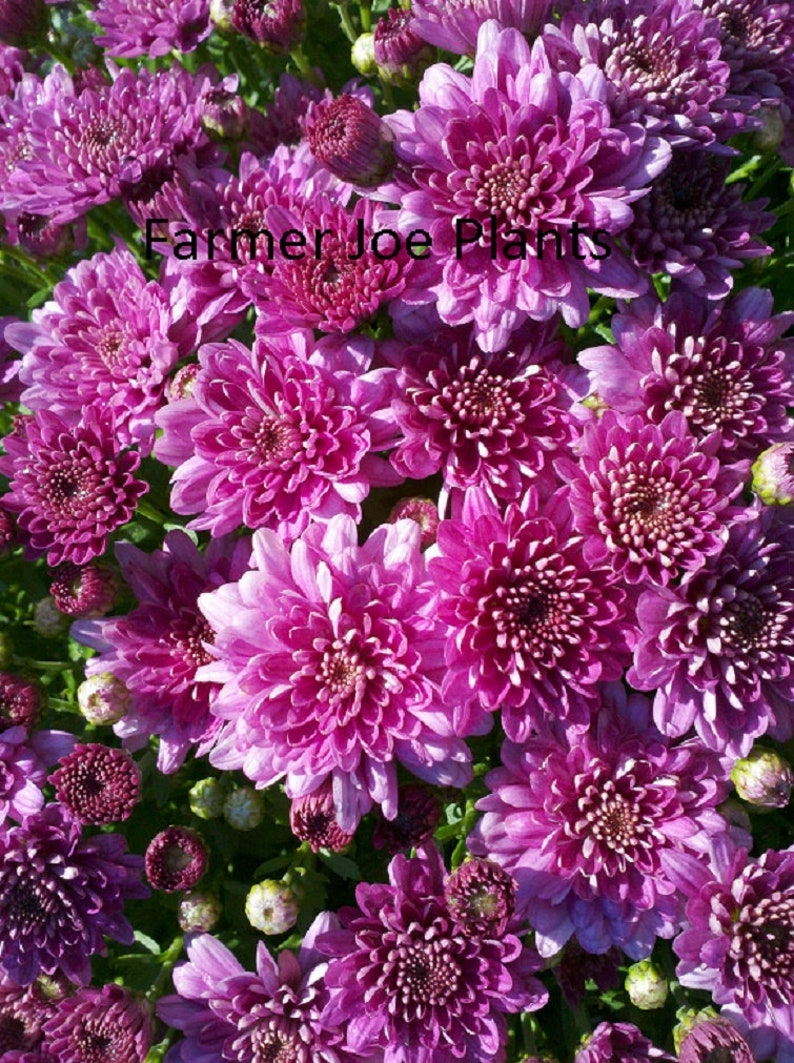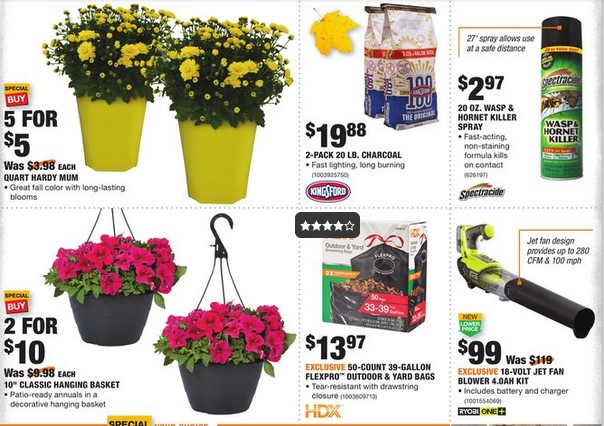If you're a gardener who craves pure splashes of single colors, try something different this year. Mimic Mother Nature's fall color show and treat yourself to a hanging basket planted with a mix of hues. Cool Wave Mix Spreading Pansy delivers a just-right blend that's eye-catching and perfect for fall.
Tuck a pot into the ground at least six weeks before frost, add extra mulch once the ground freezes, and you'll be rewarded with early spring pansies. Cool Wave pansies handle temperatures as low as minus 13° Fahrenheit. They'll look frozen solid during winter, and leaves and stems may turn brown, but watch what happens when spring peeks around the corner.
Of course, plants in pots won't survive freezing temperatures. If you plant hardy mums in the fall, they likely won't survive the winter. Instead, you can try letting the plants go dormant in their pots and keeping them in a cold but frost-free indoor spot like a garage until the following spring.
Then you can plant the mums outside in your garden once the soil has warmed up again. You should soon see new growth appearing from the roots if your plant is still alive. If you live in a cold climate, it is best to leave the foliage on the plant, even after it has browned and died, to increase the plant's chance of surviving the winter. In spring, you can prune out the dead leaves before the new ones start to develop.
A lot of people buy perennial mums, plant them, and then are upset when they don't come up the next year. If you want fall mums, your best bet is to plant mum seeds in the spring so that the flower has enough time to get situated and establish strong roots. 'Kirigami' ornamental oregano isn't meant for the kitchen — it's purely a garden delight with its colorful bracts and lightly fragrant flowers. During autumn's cool nights, the rose-purple bracts on 'Kirigami' (Origanum x hybrid 'Kirigami') deepen in color.
Look for this beauty in spring to grow all summer long and into fall. Or pick it up at garden centers in autumn to decorate outdoor spaces until hard frost arrives. This oregano is winter hardy in planting beds in Zones 5b-8b. Tuck it into the garden at least six weeks before hard frost to help ensure winter survival. Next spring, dig it and pot it, or enjoy its trailing stems in the garden.
Look for new Skyfall mums to create the perfect porch-size garden mum orb. Traditional garden mums don't always make the prettiest hanging baskets because their stems don't naturally trail and can be brittle. These trailing mums adapt beautifully to hanging baskets, cascading naturally.
The petite daisy blooms beckon butterflies to the frost-tolerant plants. Look for flower colors of yellow, white, pink, purple and red. Plant at least six weeks before frost to help ensure winter survival.
Chrysanthemums often appear for sale at your local garden center or grocery store long before summer is over. But hold onto your pumpkin spice latte, should you buy these seasonal plants just yet? A favorite for outdoor fall decor, mums burst into bloom just when many other summer-flowering plants like zinnias and petunias start winding down in the cooler autumn weather. That's why a few potted mums perched on your porch seems like a no-brainer for transitioning from summer into the next season. But don't be in too much of a hurry if you want your plants to last. Even though retailers start selling mums well before fall begins, you may want to hold off on buying them just yet.
Choose garden mums that have not yet begun to bloom, and check plant tags for flower form and color. Plant each piece in a new hole with some organic matter and fertilizer. 2) Regardless of the age on your mums, they can be propagated through cuttings. When a new stem is about 6" tall, break off or cut the top 4". Dip the cut end into some rooting hormone (this isn't absolutely necessary) and plant the cutting into a pot with sterile potting soil or a mix of sand and peat moss.
There should be bright light, but no direct sun. In about two weeks the cuttings will have formed roots. Before planting the cuttings in the outdoor bed, gradually acclimate them to brighter light.
Fall garden mums can be planted either as young plants in the spring or as flowering plants in the fall. Beautiful garden mum hanging baskets can also be created to add a finishing touch to any landscape. After the last pinch your garden mum will grow to be more than double in size. Perfect for a hot dry situation, Achillea millefolium "Peach" is a lovely soft, peach shade that deepens to a soft vintagey rose pink.
You simply cant go past Achilleas in a cottage garden, naturalistic and wildflower garden, but they look equally stunning in your perennial border. Florists love this flower given the mosaic of colours in one flower as well as its longevity in a vase. Full sun will give you the best blooms from late Summer right through into autumn. Loved by bees, butterflies, and other pollinators.
After the first flowering, you can shear the plant back to encourage new growth and flowers. Plants are easily split, this can really be done at any time but be sure to keep them moist until established. To do their best, chrysanthemums should be planted in well-drained beds that receive at least six hours of sun daily.
After they finish flowering, garden mums should be cut back far enough to remove all of the faded flowers (about one-quarter their height). If the winter stays very mild, some mums will produce a few more flowers. In late January or early February, garden mums should be cut back to about three inches from the ground. They will stay dormant through the winter and are completely hardy here.
New growth usually begins in February or early March when new shoots appear at the base of the old stem stubs. These mums are actually perennials as long as they're properly planted and given the right care, so they make good choices for brightening up your fall garden. First of all each HD has a manager that runs his/her store as they see fit.
Each associate is trained for their individual department. I work as a garden associate and we have 16 hours of horticulture certification and another 8 hours of nursery consultant certification. Yes, we do know the answers to your questions and more.
Cashiers are just that and people that load stuff for you do not. Don't expect them to be knowledgeable about such things. Our Garden dept manager IS a master gardener.
Our plants are NOT owned by HD and are brought in by vendors. Vendors WANT and LOVE a chance to put their plants on HD shelves to sell because they make more money by doing so in the hundreds of HD stores than they would selling themselves. Their merchandise is what we call pay by scan which means if it's not sold it is no loss to HD and if it is then the profit is shared. Therefore HD cannot mark down plants that do not belong to them so don't ask for the half dead plants that are being thrown away. It's not our choice but the vendors choice to throw them out. Possible reasoning is it cost to much to them to ship them back, they could be weaker and have diseased.
The HD as does the vendor does not want unhealthy plants on the shelves. Our vendors DO MARK down some plants at their descretion. The vendors have people hired that come in and display their plants and put them out on the racks.
HD for the summer has hired outside help to water plants. It is so important to us we have what is called the VOC. On your HD receipt you'll find a web link to go to that questions your service at our store. When our associates have made you happy and you tell us that, the associate receives an award. So, yes, we strive to put that smile on your face. Plant the mums in well-draining soil that receives full sun.
If the mums produce spring blooms, pinch them back before late summer to encourage fall flowering. Before winter, cover plants with several inches of mulch or straw. Mums grow best with full morning sun, at least 5-6 hours daily. Water when the soil feels dry and add more mulch before your average first fall frost date.
You can prune the mums in the late fall or in the spring. It's also adviced to pinch off the tops of stems in the spring to ecourage bushier growth and more flowers. Add some compost and/or aged manure to the soil in the spring.
Perennial plants typically have a shorter blooming season, ranging from two to three weeks depending on the type. You can help offset this by planting flowers together that bloom early, mid-season and late for a continual splash of color. Brighten up your garden's shady spots with some butterfly and bird attracting full shade perennials. We also offer full sun perennials for those spots in your garden that get lots of sunlight. And if you live in a dry climate, check out our selection of drought resistant perennials.
In cold regions, this is too late to plant mums and expect them to survive winter. The best time to plant fall purchased garden mums is the minute you buy them, which should be as soon as you see them for sale. Early planting—even as early as late August—helps plants develop a strong root system. Although garden mums are often called hardy mums, they may not survive the winter if drainage is poor or if you live in an extremely cold climate. If your mums survive the winter, you'll see new growth developing around the base of the plant in early spring. Propagating mums is a task that you can enjoy as a home gardener.
The variety of methods for reproduction means you just have to decide how to start mums. Chrysanthemums make excellent potted plants for special occasion gifts or as perennials in the garden bed. You can bring them indoors or out for early spring or late fall color. Flowering mums planted in the fall don't consistently make it through the winter.
The plants don't have the time to extend their roots beyond the pot-bound root ball into the soil. The fragile roots are damaged by frequent cycles of freezing and thawing over the winter. Some growers have had success by wintering mums in a cool, dry location (garage, porch, etc.) that doesn't freeze. After cutting off the foliage, keep these plants barely moist throughout the winter . Expose them to warmer temperatures and more water once the threat of frost is past. As perennials, mums are genetically programmed to lose their top growth to the frost, go to sleep for the winter, and wake up with the warm temperatures of the spring.
When the foliage succumbs to frost, cut the plant back to the ground. Apply a thick layer of mulch (chopped leaves, pine needles, etc.) over the plants. When spring arrives and the threat of frost is over, pull back the mulch and watch your mums rapidly grow. I don't work for HD but do work for a BB store and my job is not in the Garden Center. So I volunteered a day every weekend this summer to come in an water to help keep plants alive when they have no one else do do it. We rarely throw plants away only mark them down.
My suggestion is to join a political party that does not promote big box store and work from there. Otherwise shop local and don't worry about what the people are doing with their money when and where they want to. If you want change it is not happening at the garden center at your local BB store. Mums are a hardy perennial plant best planted in the spring, but mums that are sold in garden centers in the autumn are really being treated as annuals. They are already in full bloom with beautiful autumn jewel-hued colors to decorate your house, along with autumn wreaths and gourds. The early to mid-spring is the best time to plant mums.
Mums may die off and only last for a single year if added later in the year such as during the fall or the onset of winter. With proper care, they will become a perennial fixture in your flower garden. Mums love sunshine, so if you live in a shaded place, mums might not be the plant for you and that's sad.




























No comments:
Post a Comment
Note: Only a member of this blog may post a comment.